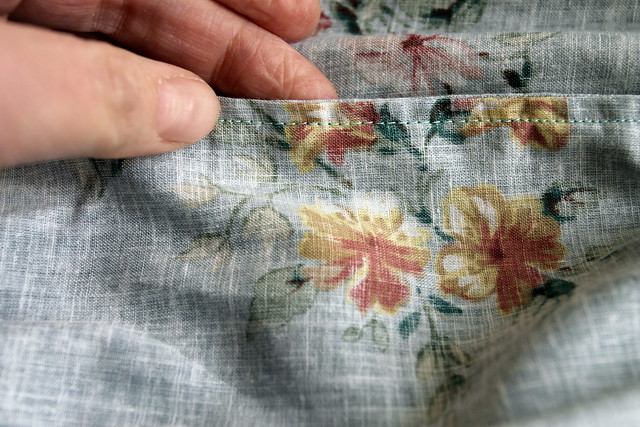My favourite seams to use particularly on childrens wear are french seams.The french seam has all raw edges enclosed and is ideal for lightweight fabrics, especially lingerie, nightwear or childrens wear, when comfort is of paramount importance, especially when seams are next to delicate skin.
I use french seams in all of these situations, but also when sewing lightweight blouses like my recent Banksia Top. If you like to sew vintage, a french seam is a useful skill to have.
This seam is ideal to use with my Flossie's Pinafore pattern, and with the free tutorial for matching Baby Bloomers.
If you'd like to be in with a chance of winning a Flossie's Pinafore pattern, take a look here.
When I first learned to sew any seams, I measured, pinned and tacked at every stage. It wasn't until I was in sixth form and studying for A Level needlework that my teacher allowed me to skip this stage. I haven't included that preperation in my tutorial, because I think I know most people are going to skip it anyway...you naughty lot!
I would say though, if you are an absolute beginner, measuring, pinning and tacking at each stage are worth it in the long run. Good preperation never hurt anyone.
French Seams:
1: Starting with fabric wrong sides together (often referred to as ws tog )

2: Using the guides on your sewing machine footplate, sew a 10mm seam. (If your machine does not have these markings, you can measure the required amount and use masking tape to make the marking on the footplate.


3: Trim your seam allowance to 3mm


4: Press seam open.


5: Turn fabric right sides together ( rs tog ) Press again.

6: This time using the notched markings on your presser foot sew a 5mm seam. ( Again you can mark 5mm on your machine footplate if your presser foot does not have the correct measured markings. )

7: Press.
Wrong side:

Right side:

Close up of wrong side:

I use french seams in all of these situations, but also when sewing lightweight blouses like my recent Banksia Top. If you like to sew vintage, a french seam is a useful skill to have.
This seam is ideal to use with my Flossie's Pinafore pattern, and with the free tutorial for matching Baby Bloomers.
If you'd like to be in with a chance of winning a Flossie's Pinafore pattern, take a look here.
When I first learned to sew any seams, I measured, pinned and tacked at every stage. It wasn't until I was in sixth form and studying for A Level needlework that my teacher allowed me to skip this stage. I haven't included that preperation in my tutorial, because I think I know most people are going to skip it anyway...you naughty lot!
I would say though, if you are an absolute beginner, measuring, pinning and tacking at each stage are worth it in the long run. Good preperation never hurt anyone.
French Seams:
1: Starting with fabric wrong sides together (often referred to as ws tog )

2: Using the guides on your sewing machine footplate, sew a 10mm seam. (If your machine does not have these markings, you can measure the required amount and use masking tape to make the marking on the footplate.


3: Trim your seam allowance to 3mm


4: Press seam open.


5: Turn fabric right sides together ( rs tog ) Press again.

6: This time using the notched markings on your presser foot sew a 5mm seam. ( Again you can mark 5mm on your machine footplate if your presser foot does not have the correct measured markings. )

7: Press.
Wrong side:

Right side:

Close up of wrong side:

























The Birthday Romper is one of my favourite patterns for Spring and Summer.
Inspired by a photograph in an old copy of Penelope Leach's Baby and Child; I pored over this book after the birth of my eldest, India. I bought it in a charity shop, it has a strong smell of perfume, and even now just flicking through it can take me right back to my first parenting experiences.
The photo in question captured my imagination. It is of a baby sleeping in a large old coach built pram, lying on a patchwork quilt wearing an adorable romper dungaree. That photo evoked in me a feeling of calm and perfection that I can't quite describe.
The Birthday Romper embodies those quite lovely feelings I have when I see or even think of the photo, and hopefully some of that is evident to others in my final design.
This week I have been working hard grading this pattern into sizes 3-6 months, 6-12 months and 12-18 months.
I've also begun sample making.
This sample will be winging it's way to a cute little tester in the next few days.
And this one will be looking for a tester in a few days.
I'm pretty happy so far with how the sample sewing is going, and hopefully the pattern will be ready to print by mid March, just in time for Spring!
I do need a little help though. As I've already said, I so far have graded the pattern in three sizes from 3 months up to 18 months. I think these are the sizes this style most suits, but I want to ask you, dear readers, would you like more sizes? A 0-3 months, and a 18-24 months?
Please let me know in the comments. And just as a little incentive, all commentors will be entered into a little draw for one of my Flossie's Pinafore patterns.